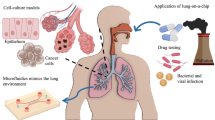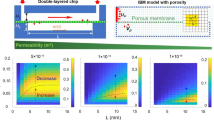Abstract
Microreactors experience significant deviations from plug flow due to the no-slip boundary condition at the walls of the chamber. The development of stagnation zones leads to widening of the residence time distribution at the outlet of the reactor. A hybrid design optimization process that combines modeling and experiments has been utilized to minimize the width of the residence time distribution in a microreactor. The process was used to optimize the design of a microfluidic system for an in vitro model of the lung alveolus. Circular chambers to accommodate commercial membrane supported cell constructs are a particularly challenging geometry in which to achieve a uniform residence time distribution. Iterative computational fluid dynamics (CFD) simulations were performed to optimize the microfluidic structures for two different types of chambers. The residence time distributions of the optimized chambers were significantly narrower than those of non-optimized chambers, indicating that the final chambers better approximate plug flow. Qualitative and quantitative visualization experiments with dye indicators demonstrated that the CFD results accurately predicted the residence time distributions within the bioreactors. The results demonstrate that such a hybrid optimization process can be used to design microreactors that approximate plug flow for in vitro tissue engineered systems. This technique has broad application for optimization of microfluidic body-on-a-chip systems for drug and toxin studies.










Similar content being viewed by others
References
Adeosun, J. T., and A. Lawal. Numerical and experimental studies of mixing characteristics in a T-junction microchannel using residence-time distribution. Chem. Eng. Sci. 64:2422–2432, 2009.
Campbell, C. J., and B. A. Grzybowski. Microfluidic mixers: from microfabricated to self-assembling devices. Philos. Trans. R. Soc. Lond. Ser. A 362:1069–1086, 2004.
Cantu-Perez, A., S. Barrass, and A. Gavriilidis. Residence time distributions in microchannels: comparison between channels with herringbone structures and a rectangular channel. Chem. Eng. J. 160:834–844, 2010.
Carlotto, S., I. Fortunati, C. Ferrante, P. Schwille, and A. Polimeno. Time correlated fluorescence characterization of an asymmetrically focused flow in a microfluidic device. Microfluid. Nanofluid. 10:551–561, 2011.
Culbertson, C. T., S. C. Jacobson, and J. Michael Ramsey. Diffusion coefficient measurements in microfluidic devices. Talanta 56:365–373, 2002.
DeMello, A. J. Control and detection of chemical reactions in microfluidic systems. Nature 442:394–402, 2006.
Dutta, D., A. Ramachandran, and D. Leighton. Effect of channel geometry on solute dispersion in pressure-driven microfluidic systems. Microfluid. Nanofluid. 2:275–290, 2006.
Esch, M. B., T. L. King, and M. L. Shuler. The role of body-on-a-chip devices in drug and toxicity studies. Annu. Rev. Biomed. Eng. 13:55–72, 2011.
Günther, A., M. Jhunjhunwala, M. Thalmann, M. A. Schmidt, and K. F. Jensen. Micromixing of miscible liquids in segmented gas–liquid flow. Langmuir 21:1547–1555, 2005.
Hartman, R. L., J. P. McMullen, and K. F. Jensen. Deciding whether to go with the flow: evaluating the merits of flow reactors for synthesis. Angew. Chem. Int. Ed. Engl. 50:7502–7519, 2011.
Hessel, V., H. Löwe, and F. Schönfeld. Micromixers—a review on passive and active mixing principles. Chem. Eng. Sci. 60:2479–2501, 2005.
Hornung, C. H., and M. R. Mackley. The measurement and characterisation of residence time distributions for laminar liquid flow in plastic microcapillary arrays. Chem. Eng. Sci. 64:3889–3902, 2009.
Huh, D., B. D. Matthews, A. Mammoto, M. Montoya-Zavala, H. Y. Hsin, and D. E. Ingber. Reconstituting organ-level lung functions on a chip. Science 328:1662–1668, 2010.
Inglesby, M. K., and S. H. Zeronian. Diffusion coefficients for direct dyes in aqueous and polar aprotic solvents by the NMR pulsed-field gradient technique. Dyes Pigments 50:3–11, 2001.
Jamnongwong, M., K. Loubiere, N. Dietrich, and G. Hébrard. Experimental study of oxygen diffusion coefficients in clean water containing salt, glucose or surfactant: consequences on the liquid-side mass transfer coefficients. Chem. Eng. J. 165:758–768, 2010.
Kola, I., and J. Landis. Can the pharmaceutical industry reduce attrition rates? Nat. Rev. Drug Discov. 3:711–716, 2004.
Nakagaki, M. The diffusion of dye solutions. Bull. Chem. Soc. Jpn. 23:104–107, 1950.
Powers, D. E., J. R. Millman, S. Bonner-Weir, M. J. Rappel, and C. K. Colton. Accurate control of oxygen level in cells during culture on silicone rubber membranes with application to stem cell differentiation. Biotechnol. Prog. 26:805–818, 2010.
Rasband, W. S. ImageJ. Bethesda, Maryland: U.S. National Institutes of Health, 1997–2011.
Ryu, G., J. S. Huang, O. Hofmann, C. A. Walshe, J. Y. Y. Sze, G. D. McClean, A. Mosley, S. J. Rattle, J. C. deMello, A. J. deMello, and D. D. C. Bradley. Highly sensitive fluorescence detection system for microfluidic lab-on-a-chip. Lab Chip 11:1664–1670, 2011.
Song, H., J. D. Tice, and R. F. Ismagilov. A microfluidic system for controlling reaction networks in time. Angew. Chem. Int. Ed. Engl. 115:792–796, 2003.
Sung, J., and M. Shuler. Prevention of air bubble formation in a microfluidic perfusion cell culture system using a microscale bubble trap. Biomed. Microdevices 11:731–738, 2009.
Sung, J., and M. Shuler. In vitro microscale systems for systematic drug toxicity study. Bioprocess. Biosyst. Eng. 33:5–19, 2010.
Tamimi, A., E. B. Rinker, and O. C. Sandall. Diffusion coefficients for hydrogen sulfide, carbon dioxide, and nitrous oxide in water over the temperature range 293–368 K. J. Chem. Eng. Data 39:330–332, 1994.
Znidarsic-Plazl, P., and I. Plazl. Steroid extraction in a microchannel system-mathematical modelling and experiments. Lab Chip 7:883–889, 2007.
Acknowledgments
This work was supported by grant W81XWH-10-1-0542 from the U. S. Army. The authors thank Richard Zotti at the CREOL Machine Shop at the University of Central Florida (UCF) for his assistance in production of the flow housings. This work was performed in part at the Cornell NanoScale Facility, a member of the National Nanotechnology Infrastructure Network, which is supported by the National Science Foundation (Grant ECS-0335765). Craig Finch thanks the Institute for Simulation and Training (IST) at UCF for donating computing time on the Stokes cluster, and IST and the NanoScience Technology Center at UCF for financial support.
Author information
Authors and Affiliations
Corresponding authors
Additional information
Associate Editor Jong Hwan Sung oversaw the review of this article.
C. Long and C. Finch contributed equally to this work.
Rights and permissions
About this article
Cite this article
Long, C., Finch, C., Esch, M. et al. Design Optimization of Liquid-Phase Flow Patterns for Microfabricated Lung on a Chip. Ann Biomed Eng 40, 1255–1267 (2012). https://doi.org/10.1007/s10439-012-0513-8
Received:
Accepted:
Published:
Issue Date:
DOI: https://doi.org/10.1007/s10439-012-0513-8




